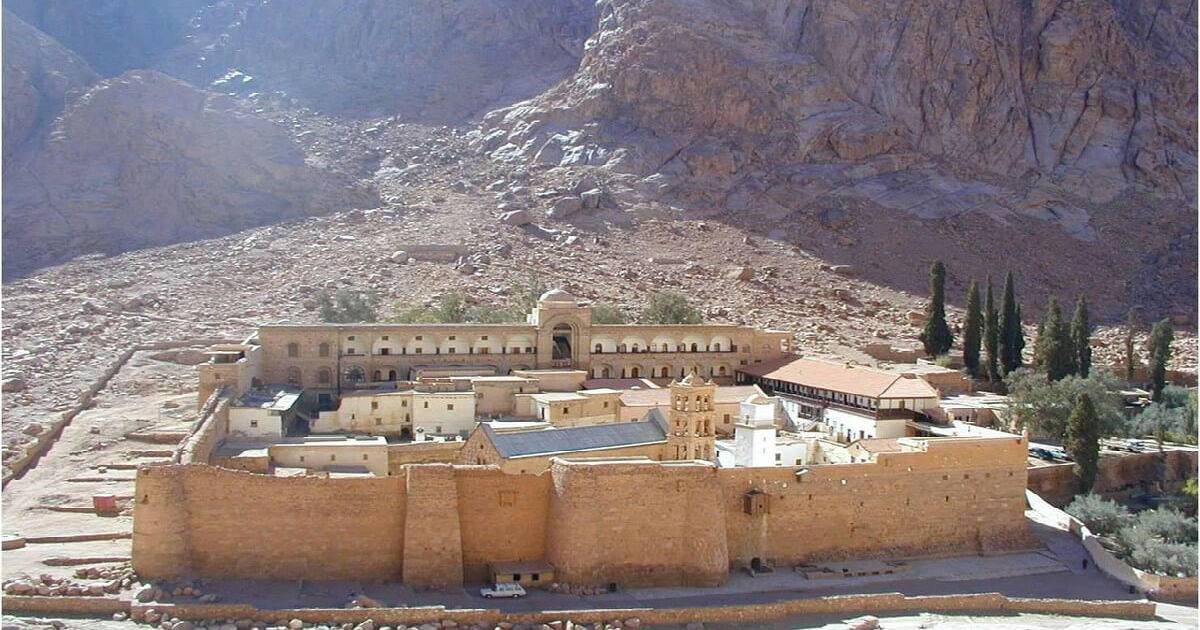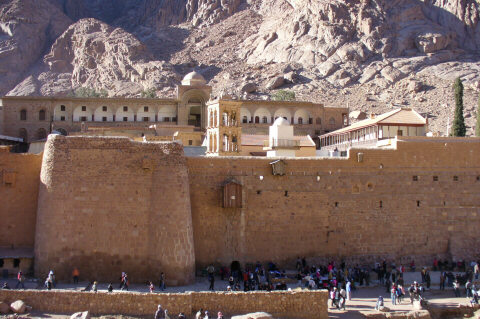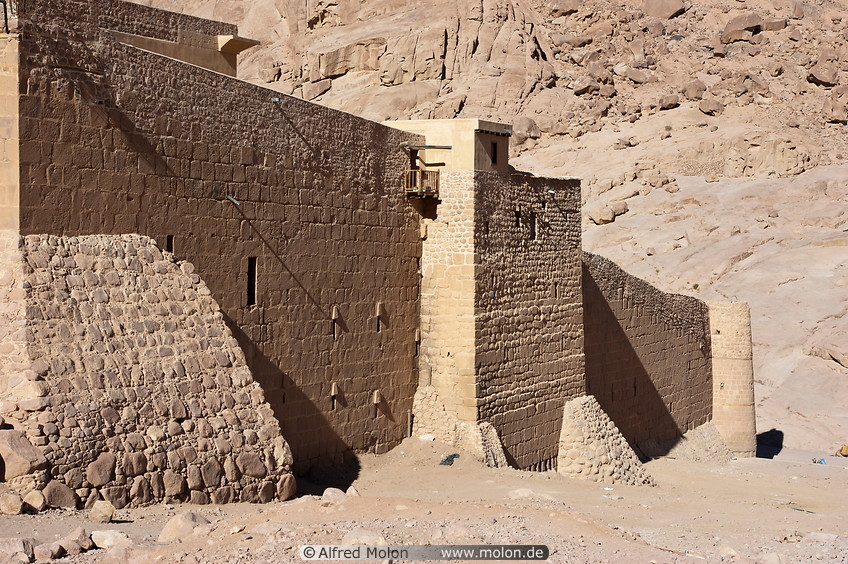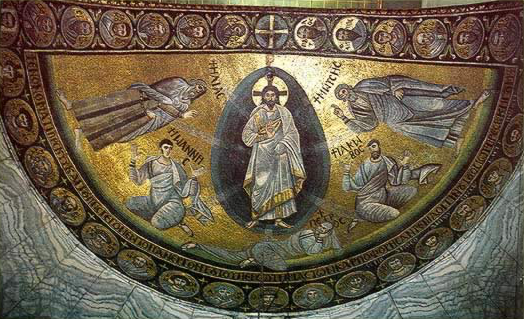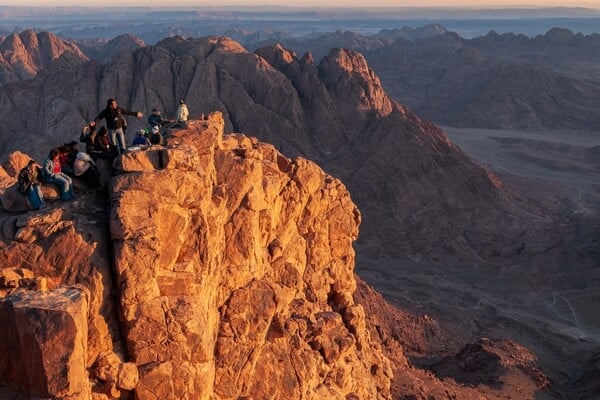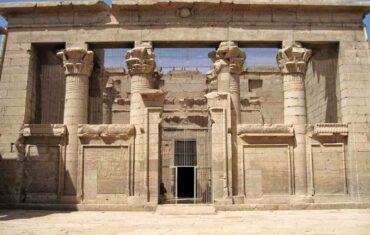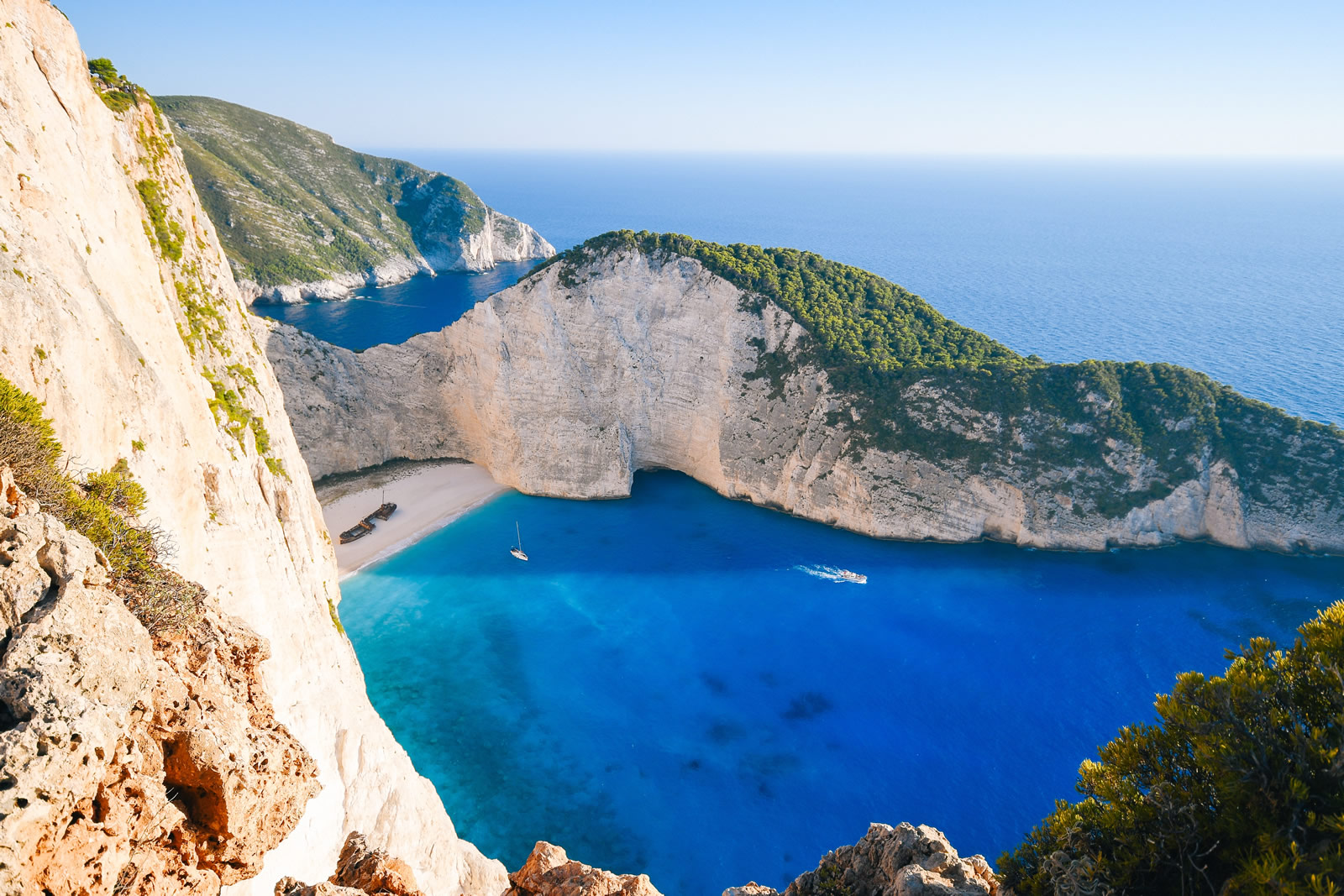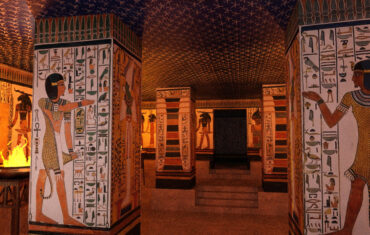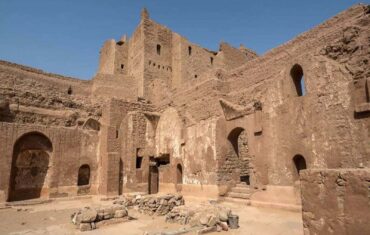Revered by Christians, Jews, and Muslims as a place of Revelation expressed in the ten commandments, mount Sinai rises above the valley where Moses heard God speaking to him from a burning Bush (the burning Bush). The burning Bush is well protected in the monastery of St. Catherine, conveniently located in a valley at the foot of the mountain, surrounded by high walls and lush gardens.
For most travelers, climbing Mount Sinai leaves an unforgettable impression, while other rarely visited peaks offer just as great views, if you are willing to make the effort to climb them.
How to get to St. Catherine’s monastery
Despite its isolated location, St. Catherine’s monastery is one of the most accessible places in South Sinai. You can visit it on organized tours from Naama Bay, Dahab, Nuweiba, Cairo, Hurghada or Eilat, or you can get there yourself by bus, car, or taxi service. The main drawback of buses is that they are not constantly scheduled and that they rarely get to the monastery of St. Catherine before it closes at noon. If you want to visit a monastery, you should expect to stay there for at least one night. A daily bus departs from Abbasiya bus station in Cairo at 11: 00 to the settlement of Saint Catherine via the Feiran oasis (8 hours).
Intercity buses from the resorts of Aqaba Gulf turn off the highway between Dahab and Nuweiba; they leave from the hay al-Nour bus station in Sharm El-Sheikh (9: 30), Dahab (9: 30),Nuweiba (10: 30) and Tabe (10:00). All buses stop 10 kilometers away in front of the monastery at the gas station. There is also a police checkpoint and a ticket office on the way to the protectorate of Saint Catherine, where foreigners must buy a ticket ($5) to enter the territory.
If you have arrived by bus and only want to climb mount Sinai, ask to be dropped off at the turn to the monastery, 1.5 kilometers away in front of the village of Saint Catherine. Alternatively, you can take a guided evening trip from Dahab or Sharm El-Sheikh, which includes climbing mount Sinai by moonlight, spending the night on the top, and returning to the monastery in the morning after dawn. Village restaurants are places to collect passengers leaving by bus; most leave between noon and 13: 00, except for the Suez bus, which leaves at 6: 00.
A group of tourists can order a service taxi in Suez, Dahab, Nuweiba or Taba and share the fare between them. Taxis usually run in the morning and afternoon, if there are customers; after the last bus leaves, taxi fares increase. The same applies to taxis leaving St. Catherine, which go to ahab and other places, depending on the requirement.
St. Catherine’s Monastery
The monastery of St. Catherine was founded by the Orthodox Greeks, not Copts. It originated in 337 AD, when the Byzantine Empress Elena ordered the construction of a chapel around a supposed Burning Bush, where hermits and pilgrims flocked. During the sixth century, robber attacks on pilgrims became more frequent, which convinced the Emperor Justinian to build a fortified fence and a Basilica, guarded by 200 guards – half of them were Greeks or Slavs. According to local legend, the Bedouins of the Jabalia tribe descend from this garrison.
Although the prophet Muhammad promised to protect the monastery after the Muslim conquest, the number of monks gradually decreased until the” discovery ” of the relics of St. Catherine, which increased the flow of pilgrims, which continued during the period of the Crusader rule (1099-1270). Since then, there have been periods of both growth and decline, and it has happened that the monastery was completely abandoned. Now there are 22 monks, most of whom came from the monasteries of mount Athos in Greece.
Visit to the monastery of St. Catherine
The monastery is open to visitors from 9:00 to 12:00 noon. It is officially closed on Fridays, Sundays and all holidays celebrated by the Greek Orthodox Church, but sometimes opens from 11:00 to 12:00 noon and on these days at the request of tourists. There is no entrance fee, but visitors must be dressed modestly. You enter through a small gate in the North wall next to the Kleber tower (named after the General of the Napoleonic army who ordered its restoration), rather than through the main gate facing West. The main gate was reinforced with special openings through which boiling oil was poured on the attackers in case of a siege.
Walls of the monastery
Built of granite, 10-15 meters high and 2-3 meters thick, the walls of the monastery have hardly changed since Stefano Aulisios designed them in the VI century. After passing through, turning right, you find yourself at Moses ‘ spring, where he met Zipporah, one of Jephro’s seven daughters, whom he married at the age of 40. Go the other way and turn the corner, you will see a prickly evergreen shrub that has outgrown the fence.
This is a transplanted Bush of the Burning Bush From which God spoke to Moses: “So, go ahead: I will send you to Pharaoh, and bring them out Egypt is My people, the children of Israel.” Skeptics may be swayed by the fact that this is the only shrub of this type on the entire Peninsula and that all attempts to grow cuttings from it elsewhere have failed. The Bush was moved to its present location when the chapel of Helena was built on top of its roots, behind the Apse of St. Catherine’s Church.
Basilica of Justinian
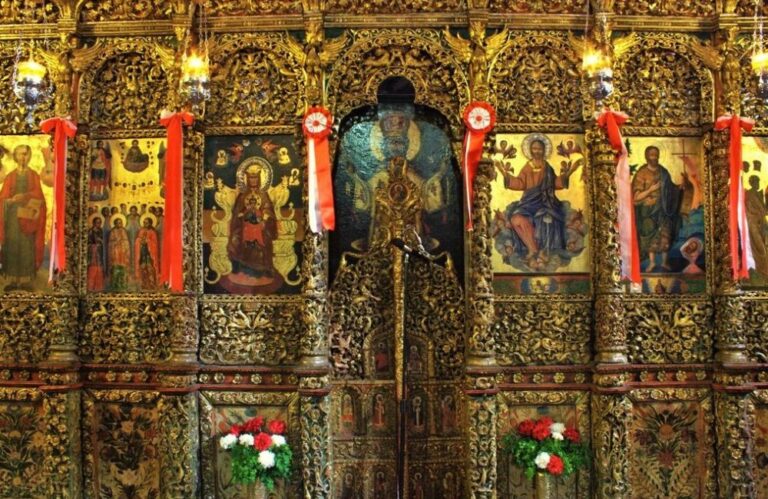
The granite Basilica of St. Catherine’s Church was erected by Justinian between 542 and 551; the walls, columns and cedar doors between the narthex and the nave are authentic. Twelve columns representing the months of the year are hung with icons of saints; carved capitals with ornaments full of symbolism. In the far corner, an elaborately carved and gilded iconostasis points to a magnificent mosaic depicting Jesus, flanked on two sides by Moses and Elijah, and Peter, John, and James kneeling at the bottom.
Unfortunately, the mosaic is enclosed, and it is difficult to see it behind the ornate candelabra suspended from the coffered ceiling of the XVIII century. Behind the iconostasis is the chapel of the Burning Bush, which can only be viewed by special permission. In the narthex, part of the monastery’s vast collection of icons is displayed, including the full range of Byzantine styles and techniques, from wax paints (encaustics) to tempera. The Church bell rings 33 times, rousing the monks before sunrise.
The rest of the monastery is often closed to the curious. Among them is an 11th-century mosque built on the initiative of Muslim rulers; a library consisting of more than 3,000 manuscripts and 5,000 books, surpassed only by the Vatican library; and a refectory with Gothic arches and Byzantine frescoes. In most cases, you can enter the crypt where the remains of the monks are buried; the cemetery is small, so the remains have to be removed from the grave after a year and transferred to the crypt. The skeleton in clothes belongs to Stephanus, who guarded one of the roads leading to the mountain in the VI century.
St. Catherine’s Settlement
While the monastery and Mount Sinai are the main attraction for tourists, most of the amenities and services for them are concentrated in the settlement of St. Catherine, located 3 kilometers away. Shuttle buses provide transport links between the two points, the fare is 5 pounds. The road ends at the main square of the village, which is also a bus station.
On one side of the square is a Bank (Monday-Thursday and Sunday 8: 30-14:00 and 18:00-21: 00), several supermarkets and restaurants; on the other side is the tourist police and a small hospital. A police station and telephone exchange are located next to the mosque. There is a small selection of restaurants (6: 00-22: 00) serving simple chicken dishes, rice and spaghetti Bolognese. Panorama also serves soup and pizza (20-25 pounds). And in the bakery opposite the mosque, they sell bread to Pete.
For short walks in the area, maps can be purchased at the Saint Catherine protectorate tourist center and the Bedouin Museum at the end of the road in front of the monastery. If you are planning to take a hike in the high-altitude region, ask the locals to show you the way to al-Milga, located on an ascent, after the main square (about 150 meters Northwest of the petrol station), where you will find Sheikh Musa, the head of Bedouin guides who organizes expeditions. For more information, see the highlands and the Feiran oasis.
Accommodation in the settlement of Saint Catherine
Most people arrive in organized tours in the early hours to climb Mount Sinai and see the sunrise. Independent travelers can leave their rucksacks in the monastery’s storeroom (2 pounds) and climb the camel trail to have a chance to sleep outdoors. When the night temperature is about 10 degrees in summer and about 0 degrees in winter (there are often frosts and snow), a sleeping bag is needed; you can also rent blankets at the top.
Keep in mind, however, that there are sometimes no places left for sleeping on the top, and you may have to lie down in Elijah’s cave and finish your journey before dawn. The best choice for travelers with a small budget is one of two recreation centers near the village of St. Catherine, although most hotels located further away will arrange transportation.
1). Pension Daniela Village – air-conditioned rooms with EN Suite bathrooms; plus a restaurant, cafeteria and bar. Location: Saint Catherine’s village;
2). Hotel / camp El Malaga Bedoin Camp is a Welcoming hotel with simple rooms for two and shared bedrooms (15 pounds), with mattresses on the floor. Very clean bathrooms. Local guide Saleh will help you organize a trip to the desert. Location: 150 meters from the cooperative gas station in the village of Saint Catherine;
3). Hotel El Wadi El Mouqudus – Friendly management and spacious three-star rooms with a refrigerator and TV, plus a swimming pool in summer. Half-Board only. Location: between the Plaza and Katherine Daniela Village;
4). The Fox Desert Camp hotel / campground is the cheapest place in the area, with simple stone cabins and moth-eaten mattresses. You can set up tents nearby for 7 pounds and use shared showers and a restaurant. Location: 800 meters from the village, near the main road intersection;
5). Katherine Plaza hotel is a Pleasant four-star hotel with air-conditioned rooms, a restaurant and a bar. Location: Outside the village;
6). Pension Morgen Land Village-Dormitories ($10) or large rooms with showers; there is also a restaurant. Location: 5 kilometers from the monastery;
7). Safari Camp is the Only budget place in the area where you can sleep on a bed instead of on the floor. Double and triple rooms are popular with tourists, and you can pitch a tent for 10 pounds. Recommended in this price range, Breakfast is included. Location: 500 meters from the village behind Katherine Plaza, also known as Moonland;
8). Saint Catherine’s Monastery Guesthouse – Located right behind the monastery walls under the red cliffs of mount Sinai, this hotel is probably the most picturesque location. Such magnificent views cannot come cheap; the double rooms are small and simple. Location: outside the walls of St. Catherine’s monastery;
9). Hotel Saint Catherine Tourist Village Is The nicest hotel in this area, with comfortable air-conditioned rooms; Breakfast and dinner are included in the price. Location: At the main road, 500 meters from the monastery.
Climbing mount Sinai
While some archaeologists doubt whether mount Sinai was really the biblical mountain where Moses received the ten commandments, it is hard not to agree with John Lloyd Stevens that “among all the wonderful works of nature, there is no more fitting place to demonstrate the power of Almighty God.” Steep and uneven, a sheer mountain range of gray and red granite “like a vengeful dagger that was dipped in blood many years ago.”
Its highest peak rises 2285 meters above sea level. The Bedouin call this peak Gebel Musa (“Mount Moses”), although this name usually refers to the entire massif as a whole. Some Bible scholars believe that Moses proclaimed the commandments from RAS Safsaf, at the opposite end of a mountain range that overlooked a wide valley where the Israelites could have camped.
Climbing to the top of mount Sinai
Neither of the two routes to the top requires a guide, but you should not attempt to climb to the top at night without a flashlight, and certainly not in winter – accidents are not uncommon. A longer, but also easier route passes through a roller-coaster-like camel trail that begins 50 meters behind the monastery.
You can rent a camel for most of the climb up the steep slope from the Bedouin at the foot of the mountain (40 pounds, 15 pounds in the afternoon; 2 hours), but it is really worth the effort and walk, it will take two to three hours. You can stock up on water at the monastery shop before you set out, and there are kiosks with drinks and snacks throughout the journey.
Their prices go up as you go up, but at least you don’t have to carry an extra load. Bedouins at the top rent blankets and mattresses for overnight stays (5-10 pounds). Beyond the crevice below the summit, the path is joined by another, known as the Sikket Sayidna Musa (“Path of our Lord Moses”), or Steps of repentance carved by a penitent monk; 3,750 steep steps make this ascent from the monastery very difficult and long (1 hour 30 minutes). Some of the steps are a meter high.
Two buildings are located on the top – a mosque and a Greek Orthodox Church; both are usually closed. Near the mosque is the cave where the Lord hid Moses: “I will set you up in a cleft of the rock, and I will cover you with My hand until I pass through.” A little further down the slope, there are several other buildings offering tired travelers a place to sleep. Many people go up the camel trail and down the steps.
Start your ascent around 17: 00 (in winter earlier) to avoid the heat and arrive in time to see the dawn. With a flashlight, you can also climb the camel trail (but not the steps) at night, although not in winter. As you descend the steps, you will see a 500-year-old cypress tree in a hollow known as the Plain of cypresses, or Elijah’s Cave, where pilgrims pray and sing. Here Elijah heard the voice of God and hid from Jezebel, crows brought him food. One of the two chapels is dedicated to him, the other to his follower Elisha.

